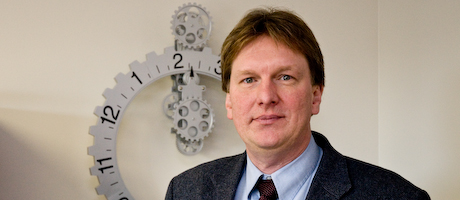By Rachel Muir
Research in Michael Plesniak’s department encompasses everything from creating mechanical vocalization that advances the treatment of voice disorders to examining how to better tap wind power and helping the U.S. Olympic kayak team maximize its stroke efficiency.
Dr. Plesniak, professor and chair of the Department of Mechanical and Aerospace Engineering (MAE), joined GW in 2008 after 17 years as a professor at Purdue University. He has also held positions as the Eugene Kleiner Professor for Innovation in Mechanical Engineering at the Polytechnic University of New York and as director of the Fluid Dynamics and Hydraulics Program at the National Science Foundation.
An expert in fluid dynamics and turbulence, Dr. Plesniak has turned his research attention from aircraft engines to biomedical flows, including speech production and cardiovascular flows. “I’ve always been interested in bioengineering, but most body processes involve laminar, or non-turbulent fluid flow,” he says. “Aeroacoustics of speech and pathological blood flow through arteries are rare exceptions that offer a wealth of challenging fluid dynamics issues.”
Dr. Plesniak explains that speech is produced by air flowing over vocal folds (also known as vocal chords), which are stretched across the top of the larynx, and causing them to vibrate during phonation. To better understand the dynamics of the process, Dr. Plesniak and his research team, funded by the National Science Foundation, created a mechanized model of the vocal folds measuring more than seven times their actual size to facilitate detailed measurements of the flow velocities.
The model is placed in a wind tunnel, enabling researchers both to examine flow during normal speech and to simulate how flow is changed with the addition of pathologies such as polyps, nodules or cysts—growths that can commonly cause speech disorders—or to investigate vocal fold paralysis. The long-term goal is to develop computer models for surgical planning to help physicians assess preoperatively how surgery will affect a patient’s voice, he says.
Researchers in the MAE department are also interested in air flows at a far greater scale—those used to harness wind power. A team led by Professor Stephen Hsu is examining how to better capture wind energy through turbines, massive structures with blades spanning more than 300 feet. Dr. Hsu has created a wind energy consortium at GW’s Virginia Science and Technology Campus composed of wind turbine industry partners, universities and national labs.
“Wind energy engineering is an interdisciplinary field that includes many areas of mechanical and aerospace engineering, such as aerodynamics, aeroelasticity, dynamics and control systems, power transmission and materials” says Dr. Plesniak. The renewable energy activities are synergistic with the GW Institute for Nanotechnology, led by Associate Professor of Engineering and Applied Science Ryan Vallance, since many of the new materials required to revolutionize the wind turbine industry will be engineered at the nanoscale.
U.S. Olympic kayakers are also looking to GW engineers for energy expertise—in their case helping them get the most effectiveness and speed out of their strokes while expending the least amount of energy. Through a partnership with the USA Canoe/Kayak team, the GW Center for Biomimetics and Bioinspired Engineering (COBRE), directed by Dr. Plesniak, is developing a system to measure the forces generated by kayakers while paddling.
Led by doctoral candidate Tewodros Mengesha and supervised by Drs. Plesniak and Vallance, the team has designed instrumentation that can be easily mounted on a paddle, measure the paddle forces and wirelessly transmit the data to a laptop. The resulting data will enable the Olympic coaches and trainers to help athletes develop more efficient strokes. “This is an interesting project in which we can apply our engineering expertise to help make our Olympic athletes more competitive,” says Dr. Plesniak. “It has also appealed to high school and undergraduate students who want to become involved in research with our graduate students and faculty.”
Dr. Plesniak says that these are just a few of the myriad activities that attracted him to SEAS. “It’s an exciting time for engineering at GW, and I’m glad to be part of bringing it to the next level of excellence,” he says.


